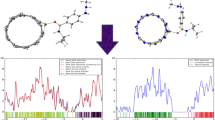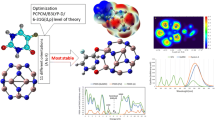Abstract
In this study, armchair graphene nanoribbons (AGNRs) and AGNRs Stone–Wales defects-based delivery nanomaterials were developed via QuantumATK and used to deliver four anticancer drugs (Hydroxyurea (HU), Thiotepa (TP), Nitrosourea (NU), and Fluorouracil (FU)). Using density functional theory (DFT), the electrical and optical characteristics of the interaction of HU, TP, NU, and FU molecules on AGNRs and AGNRs-SW defects were investigated. The results indicate that AGNRs and AGNRs-SW are more stable and less reactive after interaction with HU, TP, NU, and FU anticancer drugs, as a consequence of the rise in total energy values. The highest Eads values for the HU/AGNRs-SW, TP/AGNRs-SW, NU/AGNRs-SW, and FU/AGNGs-SW structures are −7.534, −5.917, −8.972, and −6.027 eV, respectively. On the basis of these values, it has been determined that AGNRs-SW has a greater attraction for HU, TP, NU, and FU molecule adsorption than other structures.





















Similar content being viewed by others
Data availability
Data sharing is not relevant to this article since no new data were produced or analyzed in this investigation.
References
Aghahosseini, A., Edjlali, L., Jamehbozorgi, S., Rezvani, M., Ghasemi, E.: Theoretical investigations of functionalization of graphene and ZnO monolayers with mercaptopurine at aqueous media: a dispersion-corrected DFT calculations and molecular dynamic simulations. J. Molecular Liquids 369, 120865–120878 (2023). https://doi.org/10.1016/j.molliq.2022.120865
Ajeel, F.N., Mohammed, M.H., Khudhair, A.M.: Effects of lithium impurities on electronic and optical properties of graphene nanoflakes: a DFT–TDDFT study. Chin. J. Phys. 58, 109–116 (2019). https://doi.org/10.1016/j.cjph.2019.01.009
Alrikabi, A.: Theoretical study of the design dye-sensitivity for usage in the solar cell device. Results in Phys. 7, 4359–4363 (2017). https://doi.org/10.1016/j.rinp.2017.07.022
An, Z., Colman, S.M., Zhou, W., Li, X., Brown, E.T., Timothy Jull, A.J., Cai, Y., Huang, Y., Xuefeng, Lu., Chang, H.: Interplay between the Westerlies and Asian monsoon recorded in Lake Qinghai sediments since 32 ka. Sci. Rep. 2, 619 (2012). https://doi.org/10.1038/srep00619
Barone, V., Hod, O., Scuseria, G.E.: Electronic structure and stability of semiconducting graphene nanoribbons. Nano Lett. 6, 2748–2754 (2006)
Chen, W-C., Hang-Ting, L., Sheng-Ting, F., Tzu-Hsuan, H., Pei-Ci, J., Ulrik, G. V-H., Petr, A. K., Keng-Hua, L., Keh-Chung, W., Chih-Yuan L.: First theoretical modeling of the bandgap-engineered oxynitride tunneling dielectric for 3D flash memory devices starting from the ab initio calculation of the band diagram to understand the programming, erasing and reliability. In: 2021 IEEE International Electron Devices Meeting (IEDM), 8.3. 1–8.3. 4. IEEE. (2021)
Cholsuk, C., Suwanna, S., Vogl, T.: Tailoring the emission wavelength of color centers in hexagonal boron nitride for quantum applications. Nanomaterials 12, 2427 (2022)
Deilam, M., Ghasemi, A.S.: Assessment of drug loading and release efficiencies of zigzag (8, 0) single-walled carbon nanotube as a Bendamustine hydrochloride drug delivery system in silico: DFT approach. Mol. Simul. 48, 282–289 (2022). https://doi.org/10.1080/08927022.2021.2009120
Deng, S., Jiang, Q., Wang, Y., Xin, L., Zhu, Y., Zhang, Y., Qiang, L.: C4B32 nanocluster as a drug delivery system for nitrosourea anticancer drug: a first-principles perception’. Molecular Phys. 119, e1808906–e1808911 (2021). https://doi.org/10.1080/00268976.2020.1808906
Donetti, L., Marquez, C., Navarro, C., Cristina Medina-Bailon, J.L., Padilla, C.S., Gamiz, F.: Towards a DFT-based layered model for TCAD simulations of MoS2. Solid-State Electron. 197, 108437–108440 (2022). https://doi.org/10.1016/j.sse.2022.108437
Dutta, S., Pati, S.K.: Novel properties of graphene nanoribbons: a review. J. Mater. Chem. 20, 8207–8223 (2010). https://doi.org/10.1039/C0JM00261E
Ezawa, M.: Peculiar width dependence of the electronic properties of carbon nanoribbons. Phys. Rev. B 73, 045432–045439 (2006). https://doi.org/10.1103/PhysRevB.73.045432
Ghaithan, H.M., Alahmed, Z.A., Qaid, S.M.H., Hezam, M., Aldwayyan, A.S.: Density functional study of cubic, tetragonal, and orthorhombic CsPbBr 3 perovskite. ACS Omega 5, 7468–7480 (2020). https://doi.org/10.1021/acsomega.0c00197
Han, M.Y., Özyilmaz, B., Zhang, Y., Kim, P.: Energy band-gap engineering of graphene nanoribbons’. Phys. Rev. Lett. 98, 206805–206808 (2007). https://doi.org/10.1103/PhysRevLett.98.206805
Ijäs, M., Havu, P., Harju, A.: Interaction of chlorine with Stone-Wales defects in graphene and carbon nanotubes and thermodynamical prospects of chlorine-induced nanotube unzipping. Phys. Rev. B 87, 205430–205436 (2013). https://doi.org/10.1103/PhysRevB.87.205430
Khodadadi, Z., Torkian, L.: Studying metal-doped graphene nanosheet as a drug carrier for anticancer drug β-lapachone using density functional theory (DFT). Mater. Res. Exp. 6, 065058–065078 (2019). https://doi.org/10.1088/2053-1591/ab102c
Khudhair, A.M., Ajeel, F.N., Mohammed, M.H.: Theoretical study of the electronic and optical properties to design dye-sensitivity for using in solar cell device. Russ. J. Phys. Chem. B 12, 645–650 (2018). https://doi.org/10.1134/S1990793118040097
Khudhair, A.M., Ajeel, F.N., Mohammed, M.H.: Theoretical (DFT and TDDFT) insights into the effect of polycyclic aromatic hydrocarbons on Monascus pigments and its implication as a photosensitizer for dye-sensitized solar cells. Microelectron. Eng. 212, 21–26 (2019). https://doi.org/10.1016/j.mee.2019.04.003
Kiani, M.K., Ghasemi, A.S., Ravari, F.: Theoretical study on carbonaceous materials as high efficient carriers for crizotinib drug in liquid water by density functional theory approach. Struct. Chem. 31, 1553–1561 (2020). https://doi.org/10.1007/s11224-020-01522-y
Kimouche, A., Ervasti, M.M., Drost, R., Halonen, S., Harju, A., Joensuu, P.M., Sainio, J., Liljeroth, P.: Ultra-narrow metallic armchair graphene nanoribbons. Nat. Commun. 6, 10177–10182 (2015). https://doi.org/10.1038/ncomms10177
Koch, M., Ample, F., Joachim, C., Grill, L.: Voltage-dependent conductance of a single graphene nanoribbon. Nat. Nanotechnol. 7, 713–717 (2012). https://doi.org/10.1038/nnano.2012.169
Li, W., Zhao, T.: Hydroxyurea anticancer drug adsorption on the pristine and doped C70 fullerene as potential carriers for drug delivery. J. Molecular Liquids 340, 117226–117234 (2021). https://doi.org/10.1016/j.molliq.2021.117226
Mirkamali, E.S., Roya Ahmadi, K.K., Goldasteh, Z.: Adsorption of melphalan anticancer drug on the surface of fullerene (C 24): a comprehensive DFT study'. Nanomed. J. 6, 112–119 (2019)
Moghaddam, M.D., Jamehbozorgi, S., Rezvani, M., Izadkhah, V., Moghim, M.T.: Theoretical treatment of interaction of pyrazinamide with graphene and h-SiC monolayer: A DFT-D3 study. Phys. E: Low-dimensional Syst. Nanostruct. 138, 115077–115085 (2022). https://doi.org/10.1016/j.physe.2021.115077
Muhsen, H.O., Almayyali, A.O.M., Al-Mamoori, A.Y., Mahmood, F.F.: Theoretical analysis of the structural and electronic properties of the interaction of boron nitride diamantane nanocrystal with the drug hydroxyurea as an anticancer drug. J. Mol. Model. 27, 1–9 (2021). https://doi.org/10.1007/s00894-021-04711-6
Nakada, K., Fujita, M., Dresselhaus, G., Dresselhaus, M.S.: Edge state in graphene ribbons: Nanometer size effect and edge shape dependence. Phys. Rev. B 54, 17954–17961 (1996). https://doi.org/10.1103/PhysRevB.54.17954
Niknam, P., Jamehbozorgi, S., Rezvani, M., Izadkhah, V.: Understanding delivery and adsorption of Flutamide drug with ZnONS based on: dispersion-corrected DFT calculations and MD simulations. Phys. E: Low-dimensional Syst. Nanostruct. 135, 114937–114948 (2022). https://doi.org/10.1016/j.physe.2021.114937
Nishiwaki, M., Fujiwara, H.: Highly accurate prediction of material optical properties based on density functional theory. Comput. Mater. Sci. 172, 109315–109320 (2020). https://doi.org/10.1016/j.commatsci.2019.109315
Peng, X., Tang, F., Copple, A.: Engineering the work function of armchair graphene nanoribbons using strain and functional species: a first principles study. J. Phys.: Condens. Matter 24, 075501–075510 (2012). https://doi.org/10.1088/0953-8984/24/7/075501
Pisani, L., Chan, J.A., Montanari, B., Harrison, N.M.: Electronic structure and magnetic properties of graphitic ribbons. Phys. Rev. B 75, 064418–064427 (2007). https://doi.org/10.1103/PhysRevB.75.064418
Prezzi, D., Varsano, D., Ruini, A., Marini, A., Molinari, E.: Optical properties of graphene nanoribbons: the role of many-body effects. Phys. Rev. B 77, 041404–041407 (2008). https://doi.org/10.1103/PhysRevB.77.041404
Rad, A.S.: Al-doped graphene as modified nanostructure sensor for some ether molecules: Ab-initio study. Synth. Met. 209, 419–425 (2015). https://doi.org/10.1016/j.synthmet.2015.08.016
Rezvani, M., Ganji, M.D., Faghihnasiri, M.: Encapsulation of lamivudine into single walled carbon nanotubes: a vdW-DF study. Physica E 52, 27–33 (2013). https://doi.org/10.1016/j.physe.2013.03.024
Rezvani, M., Ahmadnezhad, I., Ganji, M.D., Fotukian, M.: Theoretical insights into the encapsulation of anticancer Oxaliplatin drug into single walled carbon nanotubes. J. Nanoanal. 3, 69–75 (2016). https://doi.org/10.22034/jna.2016.03.001
Salih, E., Ayesh, A.I.: Pt-doped armchair graphene nanoribbon as a promising gas sensor for CO and CO2: DFT study. Phys. E: Low-Dimen. Syst. Nanostruct. 125, 114418–114428 (2021). https://doi.org/10.1016/j.physe.2020.114418
Son, Y.-W., Cohen, M.L., Louie, S.G.: ’Energy gaps in graphene nanoribbons. Phys. Rev. Lett. 216803–216806 (2006). https://doi.org/10.1103/PhysRevLett.97.216803
Son, Y.-W., Cohen, M.L., Louie, S.G.: Half-metallic graphene nanoribbons. Nature 444, 347–349 (2006b). https://doi.org/10.1038/nature05180
Song, A., Shi, R., Hongliang, Lu., Wang, X., Yuanzhong, Hu., Gao, H.-J., Luo, J., Ma, T.: Fluctuation of interfacial electronic properties induces friction tuning under an electric field. Nano Lett. 22, 1889–1896 (2022). https://doi.org/10.1021/acs.nanolett.1c04116
Stone, A.J., Wales, D.J.: Theoretical studies of icosahedral C60 and some related species. Chem. Phys. Lett. 128, 501–503 (1986). https://doi.org/10.1016/0009-2614(86)80661-3
Tanreh, S., Shameli, A., Balali, E.: Study on sunitinib adsorption on graphene surface as an anticancer drug. J. Appl. Chem. Res. 12, 79–91 (2018)
Tanreh, S., Rezvani, M., Ganji, M.D.: Molecular simulation investigations on interaction properties of the teriflunomide–chitosan complex in aqueous solution. J. Phys. Chem. Solids 174, 111171–111182 (2023). https://doi.org/10.1016/j.jpcs.2022.111171
Vuong, B.X., Hajali, N., Asadi, A., Baqer, A.A., Hachim, S.K., Canli, G.: Drug delivery assessment of an iron-doped fullerene cage towards thiotepa anticancer drug. Inorganic Chem. Commun. 141, 109558–109564 (2022). https://doi.org/10.1016/j.inoche.2022.109558
Wakabayashi, K.: Electronic transport properties of nanographite ribbon junctions. Phys. Rev. B 64, 125428–125442 (2001). https://doi.org/10.1103/PhysRevB.64.125428
Wang, M., Li, C.M.: Excitonic properties of graphene-based materials. Nanoscale 4, 1044–1050 (2012). https://doi.org/10.1039/C1NR10885A
Wang, M., Wang, Y.C., Zhao, H.X., Song, S.X.: Optical properties of armchair graphene nanoribbons with Stone-Wales defects and hydrogenation on the defects. RSC Adv. 5, 68722–68727 (2015). https://doi.org/10.1039/C5RA08836D
Wu, J., Pisula, W., Müllen, K.: Graphenes as potential material for electronics. Chem. Rev. 107, 718–747 (2007). https://doi.org/10.1021/cr068010r
Yan, L., Shen, J., Wang, J., Yang, X., Dong, S., Saijun, Lu.: Nanoparticle-based drug delivery system: a patient-friendly chemotherapy for oncology. Dose-Response 18, 1559325820936161–1559325820936172 (2020). https://doi.org/10.1177/1559325820936161
Yang, X., Dou, Xi., Rouhanipour, A., Zhi, L., Räder, H.J., Müllen, K.: Two-dimensional graphene nanoribbons. J. Am. Chem. Soc. 130, 4216–4217 (2008). https://doi.org/10.1021/ja710234t
Yazyev, O.V.: A guide to the design of electronic properties of graphene nanoribbons. Acc. Chem. Res. 46, 2319–2328 (2013). https://doi.org/10.1021/ar3001487
Zhihong, Y., Ye, Y., Pejhan, A., Nasr, A.H., Nourbakhsh, N., Tayebee, R.: A theoretical study on the pure and doped ZnO nanoclusters as effective nanobiosensors for 5-fluorouracil anticancer drug adsorption. Appl. Organometall. Chem. 34, e5534–e5543 (2020). https://doi.org/10.1002/aoc.5534
Funding
This study received no particular support from governmental, commercial, or not-for-profit funding entities.
Author information
Authors and Affiliations
Contributions
All authors contributed to the study conception and design. Material preparation, computations, data collection and analysis were performed by Alaa M. Khudhair. Ali ben Ahmed verified the analytical methods and supervised the findings of this study. The first draft of the manuscript was written by Alaa M. Khudhair. All authors discussed the results and contributed to read and approved the final manuscript.
Corresponding author
Ethics declarations
Conflict of interest
The authors declare that they have no conflict of interest.
Ethical approval
This research did not contain any studies involving animal or human participants, nor did it take place on any private or protected areas. No specific permissions were required for corresponding locations.
Additional information
Publisher's Note
Springer Nature remains neutral with regard to jurisdictional claims in published maps and institutional affiliations.
Rights and permissions
Springer Nature or its licensor (e.g. a society or other partner) holds exclusive rights to this article under a publishing agreement with the author(s) or other rightsholder(s); author self-archiving of the accepted manuscript version of this article is solely governed by the terms of such publishing agreement and applicable law.
About this article
Cite this article
Khudhair, A.M., Ben Ahmed, A. Anticancer drugs delivery and adsorption computations in pure and Stone–Wales defect armchair graphene nanoribbons. Opt Quant Electron 55, 812 (2023). https://doi.org/10.1007/s11082-023-05069-0
Received:
Accepted:
Published:
DOI: https://doi.org/10.1007/s11082-023-05069-0




